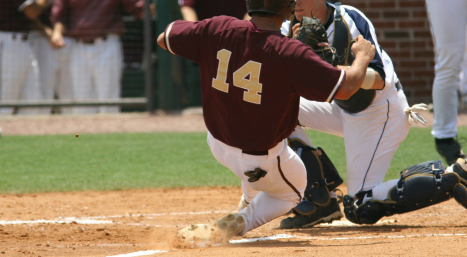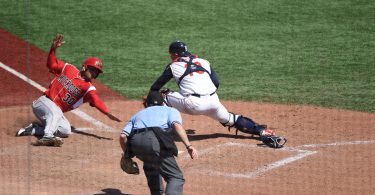The Situation:
There are runners at 1st and 3rd with one out in the top of the 5th inning of a huge game. The defense is clinging to a 1-0 lead and there is a 1-1 count on the batter.
The Play:
The pitcher delivers a fastball that runs in on the batter’s hands as he swings. The hitter is jammed and the result is a slow bounding ground ball towards the shortstop side of the third baseman. The runner at third breaks for home immediately. The third baseman charges hard in and towards the mound. He gets around the ball nicely, fields it will two hands at waist height, aligns his feet to home as he makes a quick transfer and fires a bullet to home.
The Outcome:
The throw is literally perfect, reaching the catcher at shoe-lace height on the third base side of home as the runner slides in. A split second after catching the ball, the runners cleats collide with the catcher’s glove. Somehow, the catcher holds on to the ball as his glove is bent back. The runner, who slid straight into home is out and the slim lead is preserved.
What Went Wrong:
Defensively, this play is an amazing demonstration of what it looks like to think the game. Watch the play here and listen to Houston Astros third baseman Alex Bregman describe why he went home with the ball rather than trying to turn the double play. This is thinking the game in a nutshell. Bregman used a past mistake (trying to turn the double play on too slow of a ground ball) to learn and make a better informed decision in the future. He didn’t know when he would get the same play again, but he was ready and prepared for when it did. It turns out his thought process and defensive practice on this play helped send his team to the World Series and win a pivotal game 7 in the ALCS.
If you watch the play carefully, and the video above has a great view, you will also notice that the route to home and the slide into home is less than ideal. Both of these are mistakes by the runner at third, who takes a poor route to home and slides right into the tag. Since the ball is chopped away from the line, switching to the inside of the baseline is not only slower and less direct, but also unlikely to make the throwing lane home from the third baseman’s angle more difficult. This cost the runner valuable fractions of a second.
The slide is also poorly controlled and the runner’s foot actually is placed to the inside of the plate where it’s easier and quicker for the catcher to get the tag down. A hook slide to the back of home play or even sliding away from the plate and reaching back with the hand likely make the runner safe and change the complexion of the game. Here is a great example of sliding away from the tag to be safe, something that warrants practicing. One play, two different outcomes. It pays off to think the game!







